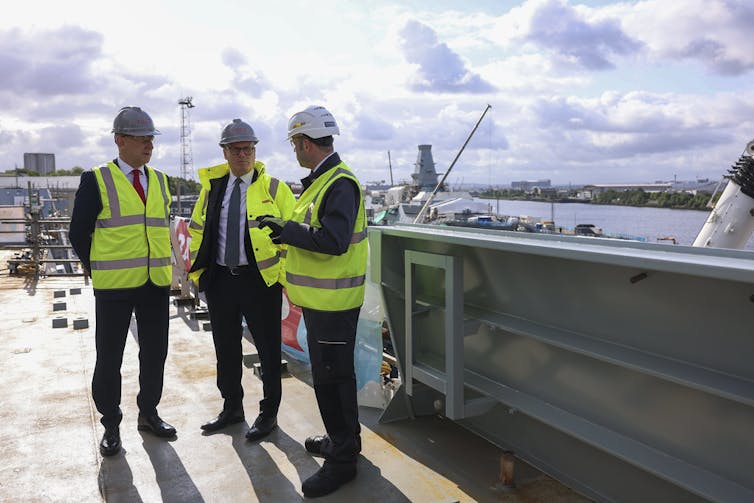The UK government’s new strategic defence review has laid out a blueprint aimed at making Britain “secure at home, strong abroad”.
The review represents a change in how the government thinks about the UK’s defence amid a rapidly changing geopolitical picture. The Labour government launched the review in July 2024 shortly after taking office, as a first step in reassessing UK armed forces in the face of Russia’s war against Ukraine. Prime Minister Keir Starmer acknowledged at the time: “We live in a more dangerous and volatile world.”
The government has accepted the review’s 62 recommendations. The most eye-catching parts are investment and development of new weapons: expanding the UK’s nuclear capabilities, drone swarms and long-range missile systems, new F-35 and updated Typhoon fighter jets and autonomous weapon systems.
Unlike past reviews, this one was conducted by experts outside of the government: former Nato secretary general Lord Robertson, former US National Security Council member and former White House adviser Fiona Hill, and retired British Army officer General Sir Richard Barrons.
In addition to practical measures of investment and expansion, the review lays out the more difficult changes that are needed to respond to security challenges, namely Russian threats to Europe. Here are three key aspects to understand.
1. War-fighting ready
The review says the UK must be “ready to fight and win” a full-scale war. Importantly, it suggests that the UK is no longer in an era of going to war when it chooses – but instead is facing the possibility of being forced into war.
Academic Mary Kaldor made the distinction between the two types of wars in her book New Wars and Old Wars, stating that old wars are “wars of necessity”, and new wars are “wars of the willing”. Published a few years after the end of the cold war, it’s easy to see why Kaldor made this distinction.
But the strategic review paints a different picture – that wars of necessity are once again the UK’s primary security concern. This means the UK must be on a different war footing than it has been since 1991.
As such, the government and the UK armed forces will have to change and become more innovative to meet this challenge. To do this, the review lays out plans for an “integrated force” model (rather than joint forces). It describes this approach as leading to “a more agile and lethal combat force”.
The review also calls for a “whole society approach”, including expanding the voluntary under-18 cadet forces, protecting national infrastructure and public outreach.
2. Pace of innovation
The review includes a host of recommendations for digital innovation and munitions production, and suggests that the defence industry could be an even bigger contributor to growing the economy. But, it notes, the UK’s defence industry is currently “stuck in cold war-era procurement cycles” and processes.
It points to a need to speed up planning and procurement and improve partnerships with the commercial sector.
Many digital innovations are being driven by industry in the US and China, such as the work on AI, nanotechnologies, robotics and automation. The challenge for the UK will be how to build good relationships with those countries on innovation which does not have a strong presence in UK digital industries.

Lauren Hurley/Number 10/Flickr, CC BY-NC-ND
3. Nato first
The reelection of Donald Trump in 2024 shocked many into thinking that the trans-Atlantic relationship was fast dissolving, though the change has been going on for some time . This review acknowledges that in setting out a “Nato first” approach:
There is an unequivocal need for the UK to redouble its efforts within the Alliance and to step up its contribution to Euro-Atlantic security more broadly – particularly as Russian aggression across Europe grows and as the United States of America adapts its regional priorities.
It states that Europe and the transatlantic area will be the UK’s primary reference for security. This marks a shift from the previous “Indo-pacific tilt” defence focus laid out in the 2021 integrated review.
The Nato-first approach seems to be at odds with the direction of Nato’s largest and most powerful member, the US. Since the end of the 1990s, US presidents have repeatedly sought to realign US grand strategy towards China and away from Europe. Had the Russian Federation not invaded Crimea in 2014, the Obama administration may have been able to carry out this pivot.
As it stands, with the second Trump presidency and its repeated calls for increasing defence spending from European states (in addition to what has often been seen as less than resolute intentions towards Russia), one might think Nato should be counting its days, rather than being placed at the centre of a new strategic review.
However, regardless of Trump’s actions, the UK will still matter for Washington for the foreseeable future, because it remains an ally and it does defence well. Nato still remains the way to do coalition-building because it has been around for so long and has built up the institutions to do high-level defence cooperation and coordination.
The review recognises the direction of travel for Washington, and how much it requires the UK and other European governments to invest in their own defence.

